at TA ≈ 25°C, VOCM pin = open, RF = 1 kΩ, RL = 1 kΩ, VOUT = 2 VPP, 50-Ω input match, G = 1 V/V,
PD = VS+, single-ended input, differential output, and input and output referenced to default midsupply for ac-coupled tests (unless otherwise noted); see Figure 8-1 for a gain of 1-V/V test circuit

| Simulated with a 1-kΩ differential load and 0.6-pF
internal feedback capacitors removed |
Figure 7-37 Main
Amplifier Differential Open-Loop Gain and Phase vs Frequency Figure 7-39 Input
Spot Noise vs Frequency
Figure 7-39 Input
Spot Noise vs Frequency
| Common-mode input to differential output, simulated
with G = 1 V/V |
Figure 7-41 CMRR
vs Frequency Figure 7-43 Common-Mode Voltage, Small- and Large-Signal Response (VOCM Pin
Driven)
Figure 7-43 Common-Mode Voltage, Small- and Large-Signal Response (VOCM Pin
Driven)
| The
VOCM pin is either driven to midsupply by low-impedance
source or allowed to float and default to
midsupply |
Figure 7-45 Output Common-Mode Noise vs Frequency
| Simulated with single-ended to differential gain of 1 ,
PSRR for negative supply to differential output |
Figure 7-47 –PSRR
vs VOCM Approaching VS–
| Total of 234 DGK units trimmed at a 5-V supply |
Figure 7-49 Input
Offset Voltage (VIO)
| 5-V
and 3-V delta from 25°C VIO, 50 DGK
units |
Figure 7-51 Input
Offset Voltage vs Temperature
| –40°C to +125°C endpoint drift, total of 62 DGK
units |
Figure 7-53 Input
Offset Voltage Drift Histogram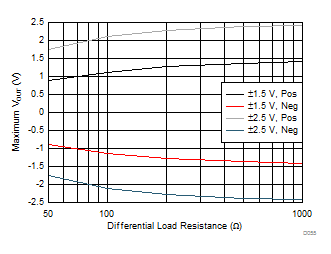
| Maximum differential output swing, VOCM at
midsupply |
Figure 7-55 ±Maximum VOUT vs Differential Load Resistance
| VOCM input floating, total of 240
units |
Figure 7-57 Common-Mode Output Offset from VS+ / 2 Default Value
Histogram Figure 7-59 PD Turn-On Waveform
Figure 7-59 PD Turn-On Waveform
| Simulated closed-loop differential output
impedance |
Figure 7-38 Closed-Loop Output Impedance vs Frequency
| Differential mode output to common-mode output,
simulated with G = 1 V/V |
Figure 7-40 Output Balance vs Frequency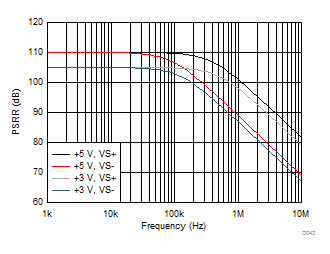
| Single-ended to differential gain of 1, PSRR simulated
to differential output |
Figure 7-42 Power-Supply Rejection Ratio vs Frequency Figure 7-44 Common-Mode Voltage, Small- and Large-Step Response (VOCM Pin
Driven)
Figure 7-44 Common-Mode Voltage, Small- and Large-Step Response (VOCM Pin
Driven)
| Average VOCM output offset of 39 units,
standard deviation < 2 mV |
Figure 7-46 VOCM Offset vs VOCM Setting
| Simulated with single-ended to differential gain of 1,
PSRR for positive supply to differential output |
Figure 7-48 +PSRR
vs VOCM Approaching VS+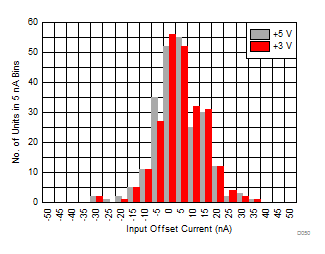
| Total of 234 DGK units trimmed at a 5-V supply |
Figure 7-50 Input
Offset Current (IOS)
| 5-V
and 3-V delta from 25°C IOS, 50 DGK
units |
Figure 7-52 Input
Offset Current vs Temperature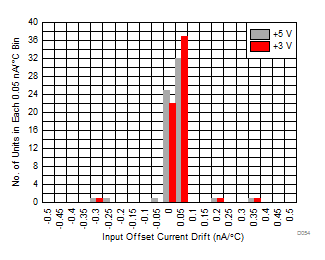
| –40°C to +125°C endpoint drift, total of 62 DGK
units |
Figure 7-54 Input
Offset Current Drift Histogram Figure 7-56 Supply Current vs PD Voltage
Figure 7-56 Supply Current vs PD Voltage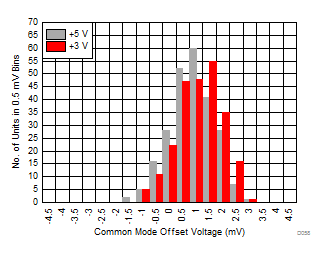
| VOCM Input driven to midsupply, total of
240 units |
Figure 7-58 Common-Mode Output Offset from Driven VOCM Histogram Figure 7-60 PD Turn-Off Waveform
Figure 7-60 PD Turn-Off Waveform


 Figure 7-43 Common-Mode Voltage, Small- and Large-Signal Response (VOCM Pin
Driven)
Figure 7-43 Common-Mode Voltage, Small- and Large-Signal Response (VOCM Pin
Driven)









 Figure 7-44 Common-Mode Voltage, Small- and Large-Step Response (VOCM Pin
Driven)
Figure 7-44 Common-Mode Voltage, Small- and Large-Step Response (VOCM Pin
Driven)







